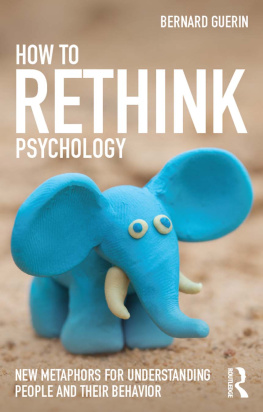Introduction
Social psychology can offer important insights into change, for instance that change and intervention are all about interaction and meaning. However, in change management the insights provided by social psychology are not used frequently enough. By understanding the perspective of social psychology, change management as a profession can continue to grow. Managers and advisers are working every day to change organizations and the behaviour of employees. At times they do so spontaneously by giving an encouraging or a disapproving response to the behaviour of a group or individual; at other times they do so as part of a well-thought-out plan to bring about a particular change. Either way they are dealing with social animals. Aristotle once said that humans are social (and political) beings by nature: man is different from other social beings because he can distinguish between good and evil, and between justice and injustice (Aristotle, 328 BC). In a conscious approach to change, one might, for instance, want to change an organizations structure or its management style. The approach can also be more comprehensive. Take the Organization Development (OD) approach: A system-wide application of behavioural science knowledge with a planned development and reinforcement of organizational strategies, structures and processes to make the organization more effective (Cummings & Huse, 1989, p. 1; our translation). In addition, from the point of view of strategy-structure-systems one can also focus unilaterally on the hard side, or from the point of view of target-process-people on the soft side (Ghoshal & Bartlett, 1996). Those two points of view can also be integrated, as in an integral model for culture change (e.g. Claus, 1991).
Social psychologist Schein (1999) distinguishes between primary anchoring mechanisms and secondary articulation and culture-reinforcing mechanisms. Primary anchoring mechanisms can be seen in the way in which leaders react to critical situationswhat do they pay attention to, what do they reject or implement? Other examples are conscious model behaviour and appointing role models. Some of the secondarymechanisms Schein indicates are organizational structures, systems and procedures, designing work areas, plus rituals and customs, stories and myths, and formal statements on the values of the organization. The approach limits itself by focusing on people at certain times, and on the systems side at other times. From a people perspective, behaviour is considered a function of the knowledge, attitudes and assumptions of individuals and groups; in these cases, interventions refer to values, leadership, collaboration and communication. From a systems perspective, behaviour is a function of the organizational system with interventions aimed at, among other things, the content of strategy and policy, organizational structure, reward systems and accountability. Ultimately, change management always concerns the possibilities and difficulties that are connected to (and influence) behavioural change on individual, group and organizational levels. People are social animals. It is all about the behaviour of and between people in social contexts. That is precisely the domain of social psychology. That profession revolves around the influence that people have on the convictions, the feelings and the behaviour of others (Aronson, 2016). However, an analysis of more than fifty bestsellers on the subject of change management shows us that social psychology is conspicuous by its absence (ten Have et al., 2017). Some books still mention Albert Bandura (for instance Bandura, 1963) and his social-cognitive learning theory. groupthink and group dynamics are referred to left and right (for instance Janis, 1982). The notion of social proof is visible in opinions about model behaviour, significant others and the dissemination of ideas (for instance Sherif, 1935; Cialdini et al., 1999). But that is about it. We are talking about the best-selling and most popular books about the profession. They often touch on the right subjects and issues, or at least the most recognizable ones from the field. At the same time, they clearly ignore an enormous amount of very relevant knowledge. Not only is that a shame, but also it is a professional irresponsibility, especially since change management usually concerns issues with a great organizational, emotional, economic and social impact. It concerns the right to exist, jobs, identity, prosperity and welfare. Notwithstanding the more widespread socio-psychological insights of eminences like Weick (1979, 1995), Lewin (1943a) and Schein (1985, 1999), from the perspective of change management the discipline of social psychology is still a sleeping giant. Given the challenges and issues that managers and advisers are faced with during change, plus the level of knowledge in the field, there is still a world to be conquered out there.
Social Psychology in the Practice of Change Management
The importance of social psychology for change management in the field became apparent, for example, when a multinational asked us to brainstorm with them about their methods and methodology for change management. In the past decade, this organization had rather successfully translated several environmental changes into strategic adjustments and organizational changes. Nevertheless, the leaders still wondered if their knowledge of change management was still sufficiently current and advanced, for now and for the future. We asked them to state the aspects of change for which, in their opinion, they had sufficient in-house knowledge. They mentioned strategic developments, economic analyses and management control, and they referred to what Bower (2000) calls the systemic culture. The latter is about control as programmed in the system of mission, values, reward systems, performance guidance, tasks-responsibilities-competences, the process of resource allocation, selection and promotion, training and development of employees and adjustmentto name but a few.
A strongly developed system of control is a positive point, but when changing circumstances require a change of course, such a positive point can become a millstone around your neck. The adage that structure follows strategy is then turned upside down: strategy follows structure (Eppink & ten Have, 2008). Strikwerda (2011) points out that the majority of enterprises forget to translate a new strategy into an adjusted systemic culture. As a consequence the activities set out to execute the new strategy are not determined by that new strategy, but by the old systemic culture. Culture grows into a product of success and failure, of what can and cannot be rewarded or punished. Culture influences the system of control, which in turn further reinforces culture through socialization, indoctrination, stimulating or demanding appropriate behaviour. Schein defines culture as follows: A pattern ofbasic assumptionsinvented, discovered or developed by a group as it solved its problems ofexternal adaptation and internal integrationthat has worked well enough to be considered valid and, therefore, to be taught to new members as the correct way to perceive, think and feel in relation to those problems (Schein, 1985, p. 9, our translation). In the briefing of the aforementioned multinational it was noted that culture change would be a point of interest, which, with the help of what went before, is understandable. There is a successful business model that gave rise to a particular culture. Except that they are not sure that this current culture will remain the cornerstone of the organization, or whether they can come up with a new systemic context. This critical self-reflection of an indisputably successful company can certainly be called positive. In the context of this case, it is interesting to see what Strikwerda (2002) has to say about advice and advisers: Modern organization advisers must not only know the socio-psychological aspects of organizational change (knowledge that is rather superficial in many advisers); the modern adviser must also be well versed in institutional economic analyses (this is on a different level than the quantitative analyses for strategy) and management control in the modern sense to be able to serve clients. Weick and Lewin have also done research on that. Thanks to their work, the field of social psychology has opened up to answer questions that are relevant to managers, and to contribute to the solutions of their problems. Strikwerda (2002) correctly stated that advisers must know the socio-psychological aspects of organizational change. The same obviously applies to managers and other participants in the field. Strikwerda also correctly noted that this knowledge is too superficial, if not entirely absent, in many advisers and managers. In other words, the available socio-psychological knowledge is insufficiently utilized. The socio-psychological knowledge being propagated is also responsible for this shortage. The example of the more than fifty bestsellers on change management (ten Have et al., 2017) mentioned earlier clearly illustrates that the quality and availability and how they are presented leave a lot to be desired.










